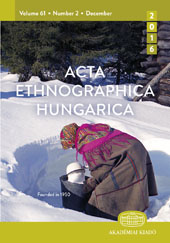“There is no Nation without History, There is no Family without a Family Tree” - On Sibe Ethnic Nationalist Aspirations through the Example of a “Family Tree Unification” Story
“There is no Nation without History, There is no Family without a Family Tree” - On Sibe Ethnic Nationalist Aspirations through the Example of a “Family Tree Unification” Story
Author(s): Ildikó Gyöngyvér SárköziSubject(s): Political history, Nationalism Studies, History of Communism, Inter-Ethnic Relations, Ethnic Minorities Studies
Published by: Akadémiai Kiadó
Keywords: ethnic minorities; nation; nation-building; nationalism; patriotism; genealogy supported by the Chinese Sibe Language and Cultural Research Center of Ili Normal College;
Summary/Abstract: The 1949 rise to power of the Chinese Communist Party (Zhongguo Gongchandang 中国共产党) was the beginning of a new era in China: the declaration of the People’s Republic of China (Zhonghua Renmin Gongheguo 中华人民共和国) was the first step on the “socialist road” leading to the creation of the long-coveted Chinese national unity. However, progress on the “socialist road” has posed many challenges for the ethnic minorities living within China’s borders. Mostly because melting into the Chinese national unity – paradoxically – became a symbol of the autonomy of ethnic minorities. In the spirit of this process, the ethnic nationalist aspirations of the Sibe (Chin. xibo zu 锡伯族; Sib. sibe uksura ᠰᡞᠪᡝ ᡠᡣᠰᡠᠷᠠ), the ethnic minority I studied, unfolded alongside the writing of Chinese national history. In my work, I follow these endeavors from the 1950s until recent times. At the center is a story that is seemingly about the knowledge base of Sibe ancestors, the family trees, and beyond that, about the “reunification” of a clan that was torn apart in 1764 by thousands of miles. But, in fact, it formulates much more than that: the idea of political martyrdom by the Sibe in the interest of creating the Chinese national unity. It is through this story that I wish to provide an insight into how Chinese national unity was created.
Journal: Acta Ethnographica Hungarica
- Issue Year: 61/2016
- Issue No: 1
- Page Range: 173-195
- Page Count: 23
- Language: English
- Content File-PDF

